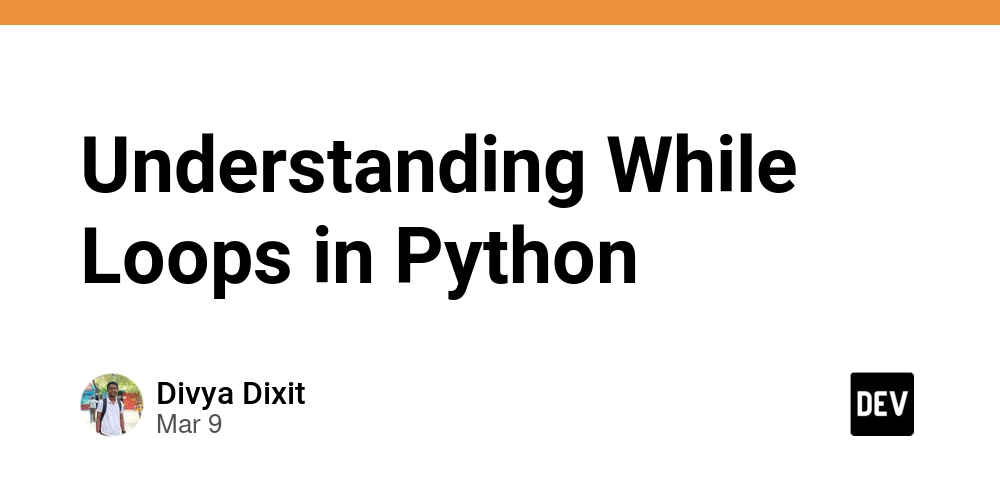Understanding While Loops in Python
In the last post, we discussed if statements, which help us skip a part of the code based on a condition. But what if we want to repeat a block of code multiple times? Instead of writing the same statement repeatedly, we use looping statements. What is a While Loop? A while loop in Python is used to execute a block of code repeatedly as long as a given condition is True. Once the condition becomes False, the loop terminates. Syntax of While Loop while condition: # Code to execute A while loop consists of three main parts: Initialization: Define where the loop starts. Condition: Set a condition that controls the loop. Increment/Decrement: Change the variable to eventually break the loop. Example: Printing Numbers from 1 to 10 Instead of writing 10 print statements, we can use a while loop: i = 1 # Initialization while i 0: # Condition print(i) i -= 1 # Decrement Infinite Loops If the loop condition never becomes False, it runs indefinitely. Be cautious! For example: i = 1 while i > 0: # Always True condition print(i) To avoid this, always ensure the condition eventually turns False by updating the variable inside the loop. Using While Loops with Break and Continue break: Terminates the loop immediately. i = 1 while i

In the last post, we discussed if statements, which help us skip a part of the code based on a condition. But what if we want to repeat a block of code multiple times? Instead of writing the same statement repeatedly, we use looping statements.
What is a While Loop?
A while loop in Python is used to execute a block of code repeatedly as long as a given condition is True. Once the condition becomes False, the loop terminates.
Syntax of While Loop
while condition:
# Code to execute
A while loop consists of three main parts:
- Initialization: Define where the loop starts.
- Condition: Set a condition that controls the loop.
- Increment/Decrement: Change the variable to eventually break the loop.
Example: Printing Numbers from 1 to 10
Instead of writing 10 print statements, we can use a while loop:
i = 1 # Initialization
while i <= 10: # Condition
print(i)
i += 1 # Increment
Example: Printing Numbers from 10 to 1
We can also print numbers in reverse order by decrementing the value:
i = 10 # Initialization
while i > 0: # Condition
print(i)
i -= 1 # Decrement
Infinite Loops
If the loop condition never becomes False, it runs indefinitely. Be cautious! For example:
i = 1
while i > 0: # Always True condition
print(i)
To avoid this, always ensure the condition eventually turns False by updating the variable inside the loop.
Using While Loops with Break and Continue
break: Terminates the loop immediately.
i = 1
while i <= 10:
if i == 5:
break # Stops the loop when i is 5
print(i)
i += 1
continue: Skips the current iteration and moves to the next.
i = 0
while i < 10:
i += 1
if i == 5:
continue # Skips printing 5
print(i)
When to Use While Loops?
- When the number of iterations is not fixed (e.g., waiting for user input, processing data until a condition is met).
- When continuously monitoring something (e.g., a sensor reading, network connection).
Conclusion
The while loop is an essential tool in Python for handling repetitive tasks efficiently. By understanding its components—initialization, condition, and increment/decrement—you can write efficient looping constructs in your programs. Experiment with different conditions and use cases to get comfortable with while loops!











































































































































































![[The AI Show Episode 142]: ChatGPT’s New Image Generator, Studio Ghibli Craze and Backlash, Gemini 2.5, OpenAI Academy, 4o Updates, Vibe Marketing & xAI Acquires X](https://www.marketingaiinstitute.com/hubfs/ep%20142%20cover.png)




























































































































![[DEALS] The Premium Learn to Code Certification Bundle (97% off) & Other Deals Up To 98% Off – Offers End Soon!](https://www.javacodegeeks.com/wp-content/uploads/2012/12/jcg-logo.jpg)


![From drop-out to software architect with Jason Lengstorf [Podcast #167]](https://cdn.hashnode.com/res/hashnode/image/upload/v1743796461357/f3d19cd7-e6f5-4d7c-8bfc-eb974bc8da68.png?#)








































































































.png?#)


































_Christophe_Coat_Alamy.jpg?#)
.webp?#)
 (1).webp?#)






































































































![Apple Considers Delaying Smart Home Hub Until 2026 [Gurman]](https://www.iclarified.com/images/news/96946/96946/96946-640.jpg)
![iPhone 17 Pro Won't Feature Two-Toned Back [Gurman]](https://www.iclarified.com/images/news/96944/96944/96944-640.jpg)
![Tariffs Threaten Apple's $999 iPhone Price Point in the U.S. [Gurman]](https://www.iclarified.com/images/news/96943/96943/96943-640.jpg)

































































































































